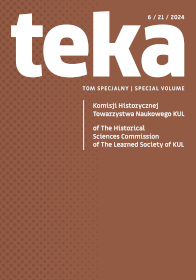„Wyspa Hyperborejczyków” Hekatajosa z Abdery – najważniejsze propozycje jej identyfikacji między XVI a XX wiekiem
„Island of the Hyperboreans“ by Hecataeus of Abdera – the most important proposals for its identification between the 16th and 20th centuries
Author(s): Piotr KochanekSubject(s): History, Modern Age, 16th Century, 17th Century, 18th Century, 19th Century
Published by: Towarzystwo Naukowe Katolickiego Uniwersytetu Lubelskiego Jana Pawła II
Keywords: Anglesey (Mona); Britain; Greenland; Heligoland; Ireland; Crete; Novaya Zemlya; Scandia; Spitsbergen; Thule and the islands on the eastern shores of the Caspian Sea
Summary/Abstract: The article presents a series of proposals for identifying the „island of the Hyperboreans“ of Hecataeus of Abdera with specific islands. This series begins with Johannes Magnus (1554) and ends with René Vallois (1926). At this time, it was proposed to associate the term „Hyperborean island“ (= Elixoia) with several known islands or areas then considered to be islands. J. Magnus considered his homeland to be the „island of the Hyperboreans“, which, following Procopius of Caesarea, he also called Scandia-Thule (1554). Lorenz Rhodomann (1604) wanted to see England as this island. Philipp Clüver identified it with the Novaya Zemlya (1616). In turn, Henry Rowlands (1723) pointed very carefully to the island of Anglesey, called Mona by the Romans. In 1740, Simon Pelloutier argued for either Greenland or Novaya Zemlya. Peter Wesseling (1745) pointed to Britain or Ireland. Jean Sylvain Bailly (1779) proposed three potential synonyms for the „Hyperborean islands“: Greenland, Novaya Zemlya and Spitsberg. In 1859, Friedrich Gottlieb Welcker pointed to Heligoland. In 1903, Friedrich Kähler suggested that the islands of Apollo worshipers should be located on one of the islands off the eastern coast of the Caspian Sea. Finally, in 1926, René Vallois was willing to locate the Hyperborean headquarters in Crete. Four identifications were particularly popular: Scandia-Thule (1554), England/Britain (1604), Novaya Zemlya (1616), and Ireland (1745).
Journal: Teka Komisji Historycznej Towarzystwa Naukowego KUL
- Issue Year: 21/2024
- Issue No: Special
- Page Range: 21-33
- Page Count: 13
- Language: Polish

